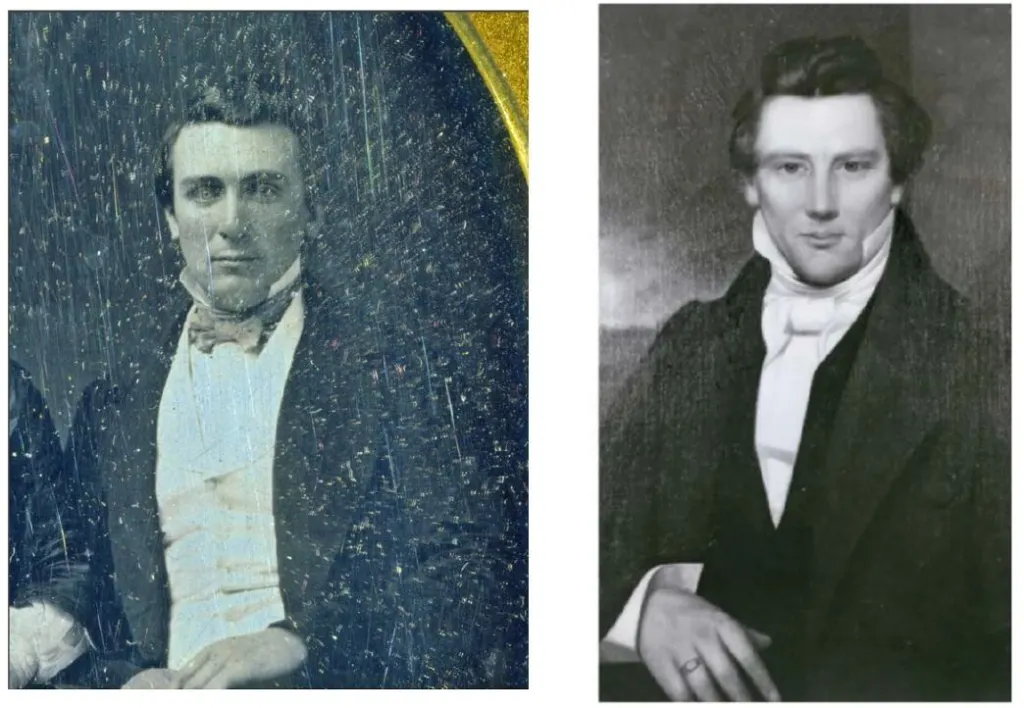

• Creator(s): Grice, F. (Francis), photographer
• Date Created/Published: [ca. 1855] {But is it really 1844?}
• Medium: 1 photograph: quarter-plate daguerreotype.
• Reproduction Number: LC-USZC4-10721 (color film copy transparency)
• Rights Advisory: No known restrictions on publication.
• Access Advisory: Original served by appointment only.
• Call Number: DAG no. 1368
• Repository: Library of Congress Prints and Photographs Division Washington, D.C. 20540
USA
What began as an investigation into the uppermost image led to a search for further details about the creator of that image, F. Grice. The Grice and Conant families shared a cause: the abolition of slavery. Francis Henry Grice was a polymath whose path seemed to often cross that of the Mormons in Missouri, Illinois, and Utah. Image 1368 in the Grice Collection at the U.S. Library of Congress might depict one such intersection. The narrative here presented cannot pass for historiography. Still, few other forms of primary sources possess the fidelity of a daguerreotype, for such an original image is a true one of a kind. The right image above is likely a painting based upon the left daguerreotype taken by Francis Grice in Lucian Foster’s studio in mid-June 1844. “Proof” of the painting’s subject is provided by the fact that the man’s awkwardly depicted right hand is actually his wife’s left hand that was copied and “transplanted” from the same daguerreotype. The ring can be seen today:
Smith Family Jewelry (historicsitesfoundation.org)
If a picture is worth a thousand words, what Grice and Conant stories are yet to be told?
So Lucian R. Foster had has photography studio at Nauvoo, Illinois. Did he hire Francis Grice to work for him?
LikeLiked by 1 person
Hi Tom
Circumstantial evidence suggests that Francis Grice may have accompanied Lucian Foster from NYC to Nauvoo in the Spring of 1844. Hezekiah Grice, the father of Francis, had connections in NYC and Philadelphia. Foster had been the President of the nascent NYC Mormon group. He arrived in Nauvoo with his DAG equipment and supplies on April 27, 1844. But he left 6-8 weeks later to return east to promote Joseph Smith’s Presidential campaign. Woodruff’s Diaries seem to confirm this. Smith was murdered on June 27, 1844. Grice had learned daguerreotyping from a Philadelphia artist cousin in Port-au-Prince, who had, in turn, studied with Daguerre in Paris. How long Grice remained in Nauvoo, I have not learned.
Rod
LikeLike
Hi Rodney! So interested to come across this article. I’ve been researching Frank Grice and I’m endlessly fascinated by him. I think there were two men named Francis Henry Grice – uncle and nephew. From dates and geography, Francis the photographer I believe was Hezekiah Grice’s brother. Hezekiah moved to Haiti where his children – including Francis – were born. The younger Francis was born in 1836 and moved to the US. I don’t think he made it any farther than the western US (living in California, Nevada, and eventually settling/dying in Utah.) I don’t know too much about the older Francis… I’ve been trying to connect a bunch of pieces together and mostly have theories at this point, but I’m totally willing to admit I may be wrong!
LikeLike
Hi Sara
Like you, I have wondered if there were two men named Francis Grice. (Actually, there was a prominent naval architect of that name and era, but I do not think he was related.) Hezekiah Grice had a son named Francis, but, as I wrote, I think he was born about 10 years earlier than 1836. I cannot be sure either, but I have convinced myself that Francis Grice took daguerreotypes of Reverends Arthur Fuller and Augustus Conant in Nauvoo in the summer of 1844. Even if a prodigy I do not think he could have been 8 years old when he did this. Francis took the only known dag of Joseph Smith just before the latter was murdered. I still am looking for “proof.”
LikeLike